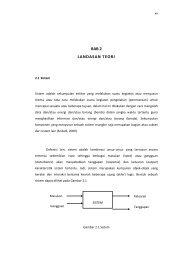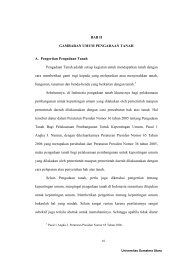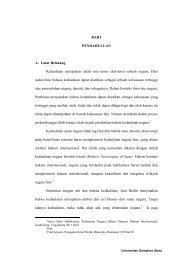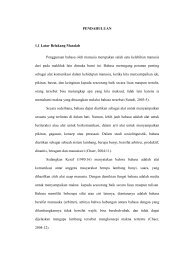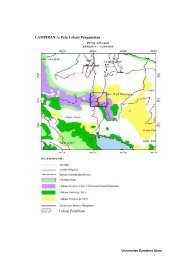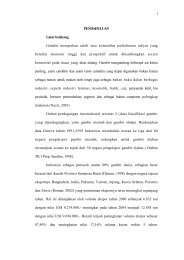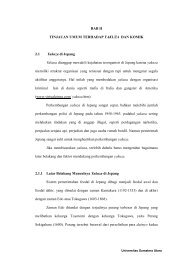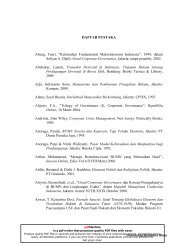CHAPTER I INTRODUCTION 1.1 Background of the Study Literature ...
CHAPTER I INTRODUCTION 1.1 Background of the Study Literature ...
CHAPTER I INTRODUCTION 1.1 Background of the Study Literature ...
Create successful ePaper yourself
Turn your PDF publications into a flip-book with our unique Google optimized e-Paper software.
<strong>CHAPTER</strong> I<br />
<strong>INTRODUCTION</strong><br />
<strong>1.1</strong> <strong>Background</strong> <strong>of</strong> <strong>the</strong> <strong>Study</strong><br />
<strong>Literature</strong> is identical with <strong>the</strong> words: <strong>the</strong> expression <strong>of</strong> human feeling,<br />
imaginative process and creativity (Wellek, 1972:2). <strong>Literature</strong> is a written work and<br />
exists in our society as a communicative means in our ideas <strong>of</strong> literature to show and<br />
give such a greater understanding about this life. Taylor (1981: 1) says that literature,<br />
like o<strong>the</strong>r parts, is essentially an imaginative act, that is, and act <strong>of</strong> <strong>the</strong> writers<br />
imaginations is selecting, ordering, and interpreting life-experience’. It means that<br />
literature is an interpretation <strong>of</strong> human’s mind that uses language as medium. It has a<br />
large scope and fantastic. In literature, <strong>the</strong>re are three branches <strong>of</strong> literature such as<br />
drama, poetry, and prose. Meanwhile, prose can also be divided into novel, short story,<br />
romance, etc.<br />
Novel is one <strong>of</strong> <strong>the</strong> literary works that are part <strong>of</strong> prose. Novel is a fictional prose<br />
narrative <strong>of</strong> considerable length, typically having a plot that is unfolded by <strong>the</strong> actions,<br />
speech, and thoughts <strong>of</strong> <strong>the</strong> characters. Novel contains some aspects that reflected based<br />
on <strong>the</strong> human real life. This aspects commonly concern with feeling, emotion, conflicts,<br />
problem, etc. <strong>the</strong> elements that build up novel are plot, characters, <strong>the</strong>me, setting, point<br />
<strong>of</strong> view, and language style. One <strong>of</strong> <strong>the</strong> most important elements <strong>of</strong> novel is characters.<br />
Talking about <strong>the</strong> characters <strong>of</strong> a literary work means talking about <strong>the</strong>ir quality <strong>of</strong> mind,<br />
behaviors, or personalities.<br />
Universitas Sumatera Utara
A character is any person, personal, identity, or entity whose existence originates<br />
from a fictional work or performance. A character is a participant in <strong>the</strong> story, and is<br />
usually a person, but may be any persona, identity, or entity whose existence originates<br />
from a fictional work or performance.<br />
Leading character is <strong>the</strong> centered individual very dominant. As an individual, <strong>the</strong><br />
leading focused personality. Leading character emerged as long side <strong>the</strong> extraordinary<br />
character, a character that might be called prototypical. The prototypical character is not<br />
a stereotypical but a fully rounded, three dimensional character.<br />
In this <strong>the</strong>sis, <strong>the</strong> writer chooses Mary Shelley’s novel entitled Frankenstein to<br />
be analyzed. Mary Shelley was an English novelist, short story writer, dramatist,<br />
essayist, biographer, and travel writer, best known for her Gothic novel Frankenstein: or,<br />
The Modern Prome<strong>the</strong>us (1818). She also edited and promoted <strong>the</strong> works <strong>of</strong> her<br />
husband, <strong>the</strong> Romantic poet and philosopher Percy Bysshe Shelley. And <strong>the</strong><br />
Frankenstein is infused with some elements <strong>of</strong> <strong>the</strong> Gothic novel and <strong>the</strong> Romantic<br />
movement and is also considered to be one <strong>of</strong> <strong>the</strong> earliest examples <strong>of</strong> science fiction.<br />
Brian Aldiss has argued that it should be considered <strong>the</strong> first true science fiction story,<br />
because unlike in previous stories with fantastical elements resembling those <strong>of</strong> later<br />
science fiction, <strong>the</strong> central character "makes a deliberate decision" and "turns to modern<br />
experiments in <strong>the</strong> laboratory" to achieve fantastic results. It has had a considerable<br />
influence across literature and popular culture and spawned a complete genre <strong>of</strong> horror<br />
stories and films.<br />
The writer wants to analyze two leading characters’ ambitions and explain <strong>the</strong><br />
effect <strong>of</strong> its ambitions to readers found in that novel. The leading characters in a story is<br />
Universitas Sumatera Utara
<strong>the</strong> character that built up <strong>the</strong> story which revealed by responds to conflict, by his or her<br />
dialogue, and through descriptions that being majority <strong>of</strong> <strong>the</strong> plot line and <strong>the</strong> reader is<br />
intended to identify with while reading <strong>the</strong> story. The leading characters which will be<br />
analyzed by <strong>the</strong> writer are Victor Frankenstein and his creature, <strong>the</strong> monster.<br />
The novel “Frankenstein” by Mary Shelley tells <strong>the</strong> story <strong>of</strong> <strong>the</strong> leading character<br />
named Victor Frankenstein who is described as an ambitious man and a scientist that<br />
really wants to create a man. However, his creation failed and turned into a monster. The<br />
monster can be considered as <strong>the</strong> leading character too because <strong>the</strong>y two, Victor<br />
Frankenstein and <strong>the</strong> monster, are <strong>the</strong> main character who lead <strong>the</strong> whole story <strong>of</strong> <strong>the</strong><br />
novel. Victor Frankenstein is always interested about <strong>the</strong> facts and wants to know<br />
everything in <strong>the</strong> universe.<br />
The writer would like to propose an idea especially about <strong>the</strong> leading characters’<br />
ambitions in Frankenstein novel written by Mary Shelley. According to Oxford (2000),<br />
ambition is something that you want to do or achieve very much and ambitious is<br />
determined to be successful, rich, and powerful by needing a lot <strong>of</strong> efforts, money or<br />
time to succeed.<br />
The writer chooses this novel because this novel is very interesting to read and<br />
can give some information about <strong>the</strong> ambitions and its effects to <strong>the</strong> readers and <strong>the</strong><br />
writer herself. In nowadays, as <strong>the</strong> reality <strong>of</strong> life, we know that a lot <strong>of</strong> people in this<br />
world want to get <strong>the</strong>ir ambitions by trying use many ways without to see its effect. The<br />
reason <strong>of</strong> writer to choose this novel because <strong>of</strong> <strong>the</strong> author’s technique in describing <strong>the</strong><br />
events, character acting, and style <strong>of</strong> <strong>the</strong> novel into her literary works so <strong>the</strong> readers can<br />
Universitas Sumatera Utara
ead it to be more interesting, enjoying <strong>the</strong> story, and can get messages from <strong>the</strong> story<br />
itself.<br />
For analyzing this <strong>the</strong>sis, <strong>the</strong> writer uses library research by collecting all<br />
necessary information to support <strong>the</strong> writer idea in <strong>the</strong> analysis. The steps used in this<br />
<strong>the</strong>sis are started by reading <strong>the</strong> novel, finding <strong>the</strong> related data and quotes that support<br />
<strong>the</strong> <strong>the</strong>me, until finally making <strong>the</strong> conclusion <strong>of</strong> <strong>the</strong> analysis.<br />
1.2 Problem <strong>of</strong> <strong>the</strong> <strong>Study</strong><br />
Based on <strong>the</strong> above explanation, <strong>the</strong> writer would like to concern <strong>the</strong> writer’s<br />
<strong>the</strong>sis in <strong>the</strong> lading characters’ ambitions, which formulated into :<br />
1. How are <strong>the</strong> leading characters’ ambitions in Frankenstein by Mary Shelley?<br />
2. What are <strong>the</strong> effects <strong>of</strong> <strong>the</strong> leading characters’ ambitions in Frankenstein<br />
written by Mary Shelley?<br />
1.3 Objective <strong>of</strong> <strong>the</strong> <strong>Study</strong><br />
The objective <strong>of</strong> this <strong>the</strong>sis tends to answer <strong>the</strong> question or <strong>the</strong> problems <strong>of</strong> study.<br />
Therefore, <strong>the</strong> purposes <strong>of</strong> this study are:<br />
1. To explain <strong>the</strong> leading characters’ ambitions in Frankenstein by Mary<br />
Shelley.<br />
2. To describe <strong>the</strong> effects <strong>of</strong> <strong>the</strong> leading characters’ ambitions in Frankenstein<br />
written by Mary Shelley.<br />
Universitas Sumatera Utara
1.4 Scope <strong>of</strong> <strong>the</strong> <strong>Study</strong><br />
The writer limits <strong>the</strong> scope <strong>of</strong> <strong>the</strong> study by analyzing two leading characters’<br />
ambitions and its effects in Frankenstein by Mary Shelley, not from <strong>the</strong> o<strong>the</strong>r characters<br />
and not on <strong>the</strong> o<strong>the</strong>r aspects <strong>of</strong> <strong>the</strong> novel. The writer believes that by scoping this study<br />
on <strong>the</strong> leading characters’ ambitions, it will give contribute to us a lot <strong>of</strong> good messages<br />
from this study in order to become more careful in choosing and running <strong>the</strong> ambitions.<br />
1.5 Significance <strong>of</strong> <strong>the</strong> <strong>Study</strong><br />
The writer hopes that <strong>the</strong> <strong>the</strong>sis will enrich our knowledge and can give some<br />
information to reader about <strong>the</strong> leading characters’ ambitions and its effects in<br />
Frankenstein by Mary Shelley and expected to give some good messages from <strong>the</strong><br />
leading characters’ ambitions and its effects itself.<br />
Universitas Sumatera Utara



